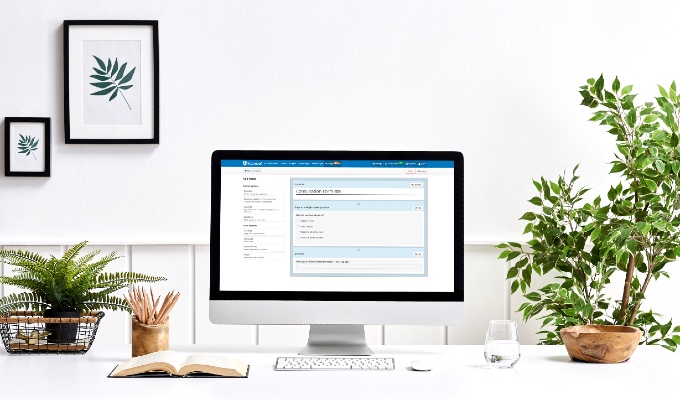A comprehensive client consultation helps you to understand your client’s goals and expectations and gives them more insight as to what they can expect from this and future appointments.
Formalising your consultation process using forms can help you and your clients to get even more out of this important part of a client visit, because it enables you and your team to provide a consistent client experience, while documenting your client’s needs.
1. Get to know your new clients
One of the most fundamental forms you can use is a new client form. Of course, you’ll be collecting client contact information on a client’s first visit, but you can also use this as a tool to help better serve their needs by getting to know their preferences, goals, lifestyle, appetite for change and how much advice they are looking for.
You could even ask about their preference for conversation or quiet time during their visit. Kitomba’s Forms feature allows your client to securely enter their information which automatically updates their client card, making it easy to update, store and access the information. It’s worth checking in with returning clients too, to ensure the information you have is up to date.
You can also send your customised digital forms to clients in advance by email or text message – allowing your clients to complete their forms whenever and wherever they choose, while reducing visit times, waiting room contact and the use of shared devices. Find out more.
2. Record consent
Some treatments will require you to obtain consent before you can complete the appointment. Protect your business from legal liability by implementing a standardised consultation process to ensure all required discussion and signatures are completed before treatment begins.
Going through this process is important for your business and also helps with building a relationship of trust with your client. It shows them that you are an expert at what you do and that you’re considering all of their individual needs.
If you use Kitomba’s Forms feature, you’ll be able to obtain a digital signature from your client, confirming that they understand the process and any risks involved in their treatment.
3. Collect and securely store important information
Discussing and capturing your client’s medical and treatment history can also be an important part of the consultation process, depending on what services you offer. Utilising a medical history form ensures you accurately and consistently collect this information, reducing the risk of missing something relevant.
This is important, sensitive information, so storing it securely, preferably in an electronic format, is essential. Kitomba’s Form feature enables you to securely store electronic documents that can’t be accessed by anyone except those with the appropriate user permissions, which will give your clients peace of mind knowing their information is secure.
4. Facilitate a treatment plan
The main goal of your client consultation is to better understand your client’s history and goals so you can create a treatment plan, whether for a single appointment or a series of appointments.
Using a form to record your recommended plan enables you to save a copy of it to the client card, along with progress photos if applicable. Then it’s easy to review the treatment plan with the client at the start of future appointments to make sure you’re still on the same page.
When booking your client’s upcoming appointments, refer back to your treatment plan to ensure return visits booked at the right time to produce the best outcome for the client.
Having a series of appointments booked in advance lets the client know what their treatment schedule is, and keeps your appointment book looking good. You can also set up automatic email or text reminders to help to reduce no shows.
5. Create consistency
Using forms to facilitate client consultations helps to create a system of quality and consistency. Ensuring each and every client receives the same care and attention in the consultation process, no matter which staff member is completing it.
Using Kitomba’s Forms feature means staff can securely access any relevant history, consents or other information you have on file before meeting with a client for the first time, and see at a glance if there are any outstanding forms or consents to be completed. That way, your client receives a personalised service every time, regardless of which staff member they meet with.
6. Provide improved aftercare
During or after each appointment, you’ll need to communicate any necessary aftercare advice to your client. Taking into account everything you have learned about your client in this appointment or previous consultations enables you to recommend the most personalised aftercare.
The ability to easily refer to your Kitomba client card records from previous appointments ensures you can offer consistent and considered recommendations and advice, even if it’s been a while since their last visit.
7. Reduce admin with electronic forms
While forms have many benefits and necessities for providing a great client experience, they often carry an administrative burden.
Copying information from paper forms into client cards, scanning and saving a copy and then filing the paper away is time consuming. This manual process can also lead to errors, such as forms being attached to the wrong client or information being incorrectly entered.
You’ll also need space to store all of the signed paper forms before eventually arranging their confidential disposal. All of this paperwork also comes at an environmental and financial cost.
However, there’s a simple solution for the administrative nightmare of paper forms. Switching to Kitomba Forms will solve these problems by automatically doing most of the admin for you, letting you go paper-free. Your clients can fill out electronic forms using a tablet in your salon, spa or clinic, or you can email or text them the form in advance. You can also choose to automatically update the client’s information upon submission. Easy!

8. Streamline your salons payment system wit Kitomba Pay
With Kitomba Pay you’ll have all the features you need to streamline your online payment process and provide a simple and secure experience for your clients.
- Improve your cash flow by getting paid faster, with funds automatically paid into your account the next business day.
- Save money with our competitive rates (domestic and international) and accept all major debit and credit cards online.
- Have peace of mind as every transaction is protected with PCI DSS Compliance and security against fraud, including 3DS 2.0 authentication protocol for an extra layer of security.
- Have complete transparency over transactions with your own Kitomba Pay merchant portal.
- Receive unlimited free support from our exceptional team available six days a week with emergency support available on Sundays.
Find out how Kitomba Pay can help you here.
Formalise your client consultations with forms
Formalising your consultation process with forms isn’t about replacing personal interaction with your clients, it’s about giving every client a consistent experience.
Sometimes it’s appropriate to leave clients to complete forms themselves, but you don’t want it to feel impersonal. Where appropriate, sit down with your clients as you usually would, using paper or electronic forms as a tool to guide your consultation. You may discuss the questions and complete the form on your client’s behalf, or support them as they complete it themselves.
Formalising your client consultation process using forms can help you to provide a more comprehensive, personalised service for each and every client visit. Taking advantage of electronic forms gives you the additional benefits of convenience and security for both your staff and clients.
To get started with electronic forms for your salon, spa or clinic, you can use Kitomba’s Forms feature. Book your free demo to find out what Kitomba Salon and Spa Software can do for your business.
Read next:
- How to introduce targets into your business
- 5 reasons why you need Online Booking
- 8 ways to get more referrals
Editor’s note: This article was originally published on 5 November 2019 and was updated for freshness and comprehensiveness.







